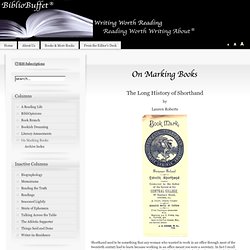

The Long History of Shorthand 04/11/10. By Lauren Roberts Shorthand used to be something that any woman who wanted to work in an office through most of the twentieth century had to learn because working in an office meant you were a secretary.

In fact I recall entering a secretarial training program right out of high school where shorthand was required. I hated it, and within two weeks, I was failing so I quit and went to college instead. I doubt shorthand is utilized in offices any more in America, though court reporters and a few other specialized fields still use it. Speed was never been a criterion in the development of written languages. Ancient Egypt, Greece and Rome all had variations. In ancient Rome, shorthand may have appeared as early as 200 B.C. Caesar wasn’t the only one to die by the pen. As the Roman Empire declined, so did shorthand. It wasn’t until 1588 that shorthand was revived in the form of a book entitled An Arte of Shorte, Swifte, and Secrete Writing by Character. J.G. A Guide to Alternative Handwriting and Shorthand Systems. Introduction The letters you are now reading, while well adapted to the eye to be read, are so ill adapted to the hand to be written that schools teach longhand as an alternative to printing them.

The more cursive longhand is easy to learn, but only about 10% faster than printing. Alternative handwriting systems offer 100% or better improvements in handwriting ease and speed. If you could spend the rest of your life taking notes or keeping a journal/diary while writing two or three times faster, then, gee, why not? As a bonus for learning an alternative system, you can be almost certain that no one you know will be able to read anything you write, so you will have learned not only a fast but secret way to write. Most alternative systems write words the way they sound, not the way they are spelled. To make up for the missing symbols, several letters are often combined to represent a sound.
With vowels things are even worse (about 20 spellings per vowel sound!). Pitman Shorthand Handywrite. Handywrite: An alternative handwriting system. A handwriting system that used the simplest possible strokes for letters would, of course, be faster to write with than longhand, which uses several, sometimes as many as four, strokes for each letter. And if the system were phonetic, words couldn't be misspelled! The usual 26 letter alphabet just doesn't have enough letters to represent all the 32+ sounds used in English, especially vowel sounds, so several letters are often used to represent a single sound. The word "ought," for example, uses five letters to write only two sounds. So a really slick form of handwriting would use one stroke for one sound. Simple, but too difficult? In the box below is a summary of everything you need to learn to start writing faster.
To better understand the above, study the following. Consonants: (as in....) n m knit—mit , knife—calm (no l sound) t d two—do , stopped (one p, ends in t)—fiddle k g coat—goat , back—ghost r l rake—lake , wrong—tell p b pin—been , happy (only one p sound)—rabbit f v fairy—very h w how—wow zh j.